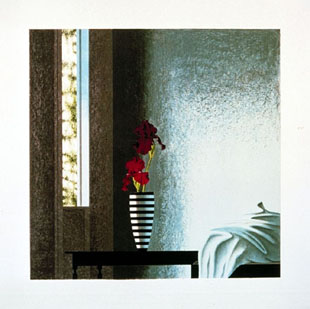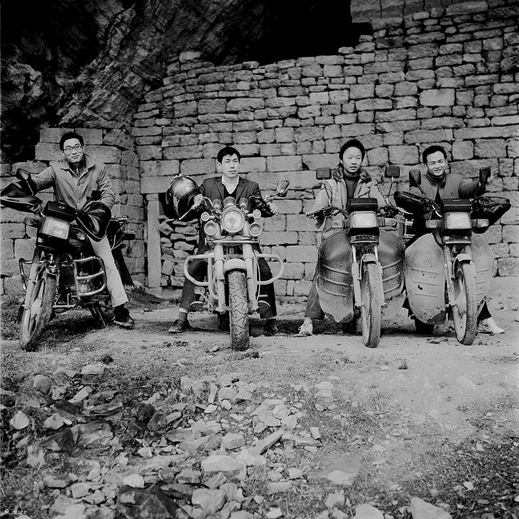 |
Focus features two in-depth reviews each month of fine art, architecture and design exhibitions and events at art museums, galleries and alternative spaces around Japan. The contributors are non-Japanese art critics living in Japan. |
|
|
 |
 |
 |
Artists Step Up: Art Charities for the Tohoku Disaster
Lucy Birmingham |
 |
 |
|
 |
Zhu Wei, "Holidays 2," ink on paper
Courtesy of the artist |
|
Bruce Cohen, "Untitled, California"
Courtesy of Tobin Ohashi Gallery
|
When times are tough, artists are always there to help, regardless of their own limited finances. The March 11 super-quake, tsunami and nuclear crisis in Japan's northeast Tohoku region is proving this true once again. Japan-based artists and art groups are rising to the occasion with events, auctions and long-term efforts to lend a helping hand to those in need.
Tokyo's Zen Foto Gallery, run by Mark Pearson and Amanda Lo, quickly organized a charity event, "Photo Auction for Tsunami Victims," and held it March 25-27. They asked photographers to donate works that would be ready for display and priced between 5,000 and 50,000 yen.
Through Gaifos (for "gaijin photographers"), its monthly gathering of foreign photographers, as well as Japanese and Chinese photography networks, the gallery got off to a good start with emails and blogs. They were overwhelmed by the positive response. "It was a big risk," said Pearson. "I didn't know of anyone else doing something like this. But it went better than we could have hoped." The few unsold works were auctioned on the 27th with prices starting at 1,000 yen.
Contributing photographers included Koichi Watanabe, who was in Fukushima when the earthquake struck; Shigenobu Yoshida, based in Tohoku; and Rob Gilhooly, a photojournalist who has gone to the area. Several well-known Chinese photographers also contributed: Wang Ningde, Mu Ge, Liu Ke and Han Chao (aka Brant).
The sales results are an impressive 2,100,000 yen. All proceeds will go to three Tohoku relief charities: Japan International Food for the Hungry, Child Fund Japan, and Plan Japan.
"We are also planning a follow-up event later in April, to show work taken by photographers currently in the affected area and those who have been there," said Pearson. "This will allow people in Tokyo to see and understand more clearly the events of recent weeks and the efforts of those trying to help the recovery. We will also be fundraising for further relief works."
Art curator Kenji Kubota also responded quickly with a more long-term effort called Japan Art Donation. "The basic idea is to ask artists and art professionals to collaborate with the affected communities to develop art projects and events," explains Kubota. "This will be for long-term emotional and psychological support. The effect is not so visible but it's very important. It's what art can do."
Kubota first sent emails to about 2,000 people asking for a message and photo. So far he's received about 80 inspiring responses. Artist Tatzu Nishi writes: "In these situations, the power of Art is probably not what first vibrates in the heart of the victims. However this is what will gradually bring them the happiness and strength to go forward. Because the power of art relates to the renewal of the present situation." Tatsuo Miyajima, artist and vice president of Tohoku University of Art & Design, writes: "We have experienced the Great Hanshin earthquake. We have also experienced 9.11. And we all know the power of art in these circumstances. There is no shortage of what we can do now and in the future. The imagination of art allows us to share in others' grieving and suffering. I believe our prayers are being conveyed to the people in the region." Mori Art Museum Director Fumio Nanjo writes: "No matter what has happened, let's think about survival. Let's think what art can do. And, let's hold onto the resolution to revive Japan."
The project has already received nearly US$400,000 in donations. Kubota is hoping to turn Japan Art Donation into a full-fledged NPO.
Tobin Ohashi Gallery, in Nihonbashi, Tokyo, held an earthquake and tsunami benefit on March 22. Now 50 percent of most of the gallery's sales will be going toward charities including Red Cross and Second Harvest. Works include Japanese prints as well as prints by leading artists such as Robert Motherwell and James Siena. Also, 10 percent of sales from their "Zhu Wei: New Paintings" show (April 1 - May 1) will go to charity.
The gallery's clientele is largely from Tokyo's foreign community, many of whom left the city after the Fukushima Daiichi nuclear power plant scare. "It's very tough because most of our customers are gone," says gallery owner Bob Tobin. "But we're able to raise some money for the charities, which is really important for us."
Taka Ishii gallery is also contributing with a show titled "NOART." At their Kiyosumi Shirakawa gallery, the walls are empty with a lone donation box set in the middle of the space. "It's just too sad for artists to display works right now and for collectors to make purchases," says Takayuki Mashiyama, in charge of the gallery's international public relations. Tomio Koyama Gallery in the same complex will be contributing a percentage of their ongoing art sales as well.
Art program director Kyoko Kuramochi has created a charity project with 100 young artists called Artists' Action for Japan. Their drawings and paintings will sell for 1,000 yen and all the money will be donated to the Japan Red Cross. The kick-off was held on March 26-27 at Tokyo's Daikanyama Hillside Terrace, and they will hold similar events in a variety of places over the next six weeks. So far they've accumulated 378,000 yen. Kuramochi writes, "I am determined to make this event worthwhile for everyone."
Although charity efforts like Artists' Action for Japan are just getting underway, Kuramochi's sentiments are being echoed in art communities throughout Japan.
 |
Mu Ge, "The Bikers"
Courtesy of Zen Foto Gallery
|
|
 |
 |
Lucy Birmingham
Based in Japan for about 20 years, Lucy Birmingham is now the Japan stringer for Time.com. She has also written for Newsweek, Bloomberg News, Architectural Digest, The Boston Globe, Artinfo.com, Artforum.com, and ARTnews, among other publications. As a photojournalist her work has appeared in The New York Times, BusinessWeek, Forbes, Fortune, U.S. News and World Report, and A Day in the Life of Japan. She is also a scriptwriter and contributing editor at NHK, Japan's public broadcaster, and has published several books including Old Kyoto: A Guide to Traditional Shops, Restaurants, and Inns. |
|
 |
|